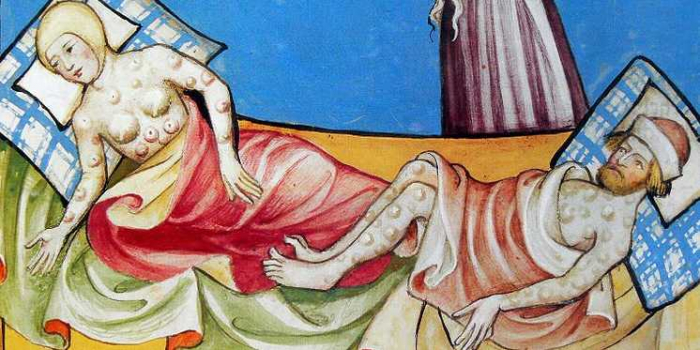Famine, plague, and war are the three most famous ingredients of this wretched world.
(Voltaire, Dictionnaire philosophique, 1764)
If it wasn’t for the Black Death, maybe you wouldn’t be reading Illustrati today. And most probably the world as we know it would be completely different.
The most terrible plague of all times originated in a faraway land, in the centre of Asia, where for some reason mice were exterminated. Fleas, that till then had been leading a quiet life sucking a bit of blood from rodents, all of a sudden became hungry and started to attack people and cattle as well. Fleas were not only annoying but also carriers of the Yersinia pestis bacterium (or, more precisely, of an ancient variant which is today extinguished).
The plague therefore started to spread in China, then quickly expanded towards the West along the Silk Route; it penetrated through the most important harbours of the Mediterranean Sea in a succession of waves, starting from Marseille. It was 1347.
The Genoese were under siege in Caffa, Crimea, and their enemy, the khan Gani Bek, used the contaminated corpses as a primitive bacteriological weapon, throwing them over the town walls. This way the infection, that the men stationed in Caffa brought back home with them, reached even the shores of Liguria. At the same time the plague entered Italy also through Venice and, in the South, through the harbours of Sicily.
The bacteria were so virulent that it spread throughout Europe as quick as flash. Confirming that it was a plague sent by God to punish the whole humankind, the infected swellings appeared on the groin, the neck and the armpits of the poor as well as of the noblemen, the notaries and the soldiers, and not a single social stratum was immune to it. Nobody could escape it, not even the Pope. The physicians of the time could not find an explanation for the plague, and people turned to astrology, divination, corporal mortification, and the unavoidable persecutions of the Jews accused of poisoning wells.
It was useless. The mors atra, “black death”, within six years (from 1347 to 1353) killed 25 million people only in Europe. The plague struck some towns more violently than others (in Florence only a man out of five survived, whereas Milan was spared), but as much as one third of the entire European population was killed by the disease.
The Black Death left behind its back a completely overturned world: malnutrition, poverty, diseases, hunger, but also war and insistent inflation. It would take a century and a half for the population to become as numerous as it was before the plague.
Nevertheless, as always, there was the reverse of the medal.
The system of medieval feudalism, first of all, couldn’t work anymore: the price of the land was enormously lowered, whereas the cost of manpower increased. Many properties had been abandoned, and became useful for sheep breeding, which started to grow very quickly, especially because it was less hard than agriculture. Peasants and farmers, therefore, had more riches at their disposal and more opportunities to advance their career; meat and animal products showed up even on the table of the lower classes.
For the first time the poor enjoyed some luxuries that were previously prerogative of the nobles – as for them, they defended themselves as they could, promulgating laws that forbad the ploughmen to wear high class clothes, and limiting the increase of the workers’ salary. But the feudatory oppression was coming to an end: within a short time it collapsed and was replaced by modalities that were more convenient for the vassals.
The scarcity of workers radically changed every social environment (corporations, for example, had to accept new members) and imposed a real cultural reorganization.
The black plague hadn’t been the end of the world, like the flagellants had predicted, but it was certainly the end of the medieval one.
To bear the brunt of the plague, in the end, were two common tools, both ancient and very powerful symbols: the pen and the sword.
According to some scholars, the lack of soldiers led to the development of firearms, recently introduced in Europe, that immediately after the plague started to be refined and developed. Over time, muskets, cannons and artillery would prove much more fearful than cold weapons.
The pen was instead the working tool of the amanuenses; as the plague had spared only a few of them, and therefore the price to copy a book was sky high, people started to consider a mechanized alternative. A century after the plague, a certain Mr. Gutenberg developed the movable type.
And modern history is unconceivable without printing, almost as without rifles.

